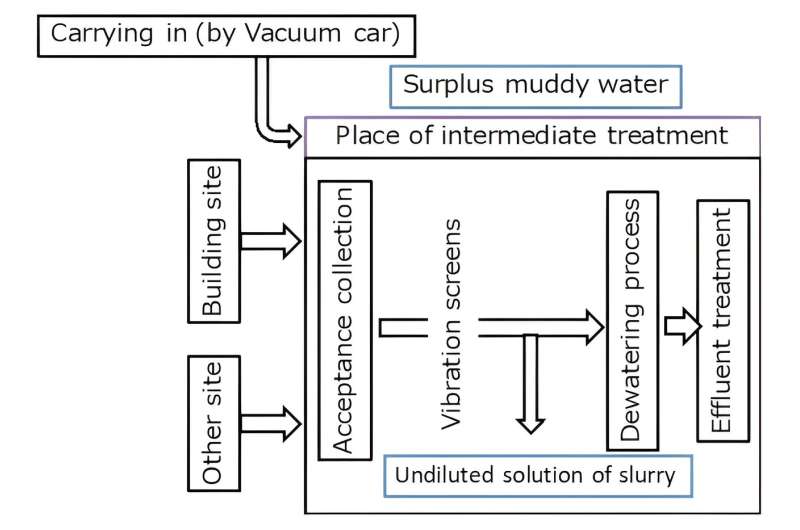This article has been reviewed according to Science X's editorial process and policies. Editors have highlighted the following attributes while ensuring the content's credibility:
fact-checked
proofread
Toward sustainable construction: Preparing liquefied stabilized soil from construction sludge

The construction industry is a highly resource-intensive and polluting sector, with significant water consumption and notable contribution to environmental degradation. According to a survey conducted by the Ministry of Land, Infrastructure, Transport, and Tourism in 2018, the Japanese construction sector discharged about 74.4 million tons of construction by-products, including 6.2 million tons of construction sludge.
In recent years, the construction industry has made efforts to reduce its environmental impact and adopt more sustainable materials and processes. Sustainable construction emphasizes efficient resource utilization, particularly water management; and circularity, wherein construction waste is recycled within the industry.
One such example of circularity in construction is liquified stabilized soil (LSS), which comprises construction-generated soil or construction sludge that is mixed with a solidifier and intermediately treated. LSS is already widely used in construction sites, especially for filling long, narrow spaces where compaction by earthworks is challenging.
The utility of LSS as a construction material lies in its flowability, which makes it easily pourable, and its strength after solidifying. LSS exhibits low permeability and high cohesive strength, making this material impervious to groundwater erosion. Moreover, it does not shrink much after casting, and its high adhesion ensures durability during earthquakes. However, despite these favorable properties, there is still scope for improving the characteristics of LSS to further expand its uses and enable more efficient construction practices.
To address this, a group of scientists from Shibaura Institute of Technology (SIT), Japan, and Kasetsart University, Thailand developed a high-flowability LSS (HFLSS) made with construction sludge (HFLSS from RCS) and examined its mechanical properties and flowability through experimental approaches.
The team led by Prof. Shinya Inazumi, from the Department of Civil Engineering at SIT, developed their HFLSS using a dewatered solution of very fine clay particles that was derived after dewatering construction sludge. This dewatered solution was blended with ordinary Portland cement as the solidifier.
This paper was published in Recycling.
"Advances in LSS could transform the construction industry and urban development. Urbanization is increasing the demand for space-efficient construction solutions, and LSS and HFLSS made from RCS could be the answer. Their application in tight, challenging spaces could lead to more efficient and sustainable infrastructure projects, while alleviating environmental concerns through the reuse of construction waste," says Prof. Inazumi.
The results of this experimental study show that HFLSS from RCS exhibits more favorable characteristics than conventional LSS for construction activities. The mechanical properties of HFLSS from RCS are lower than those of conventional LSS, whereas its flow value or flowability is higher than normal LSS (0.54m vs. 0.44m), owing to its lower specific gravity.
The high flowability of HFLSS from RCS also results in a lower unconfined compressive strength than conventional LSS (515 kN/m2 vs. 1000 kN/m2). Usually, the unconfined compressive strength required for ordinary backfilling is ≥100–300 kN/m2, suggesting that HFLSS from RCS also meets this requirement.
These results establish HFLSS from RCS as a more efficient and advanced form of LSS extending its applications beyond the usual backfill/filling and road construction. With its high flowability, HFLSS from RCS can fill narrow spaces, such as waste pipes, making it more suitable for use within complex structures. Further, it can also be pumped for distances of 500m and more at lower pressures, decreasing intermediate work and construction time.
"These findings position HFLSS from RCS as a promising sustainable material for large-scale civil engineering projects. Future research on improving this material could revolutionize the construction industry. Overall, its implications are vast—from reduced construction waste and environmental impact, to faster, more efficient urban development, which would benefit economies and promote a sustainable future for generations to come," concludes Prof. Inazumi.
More information: Yuji Shigematsu et al, Properties of High-Flowability Liquefied Stabilized Soil Made of Recycled Construction Sludge, Recycling (2023). DOI: 10.3390/recycling8050067

















